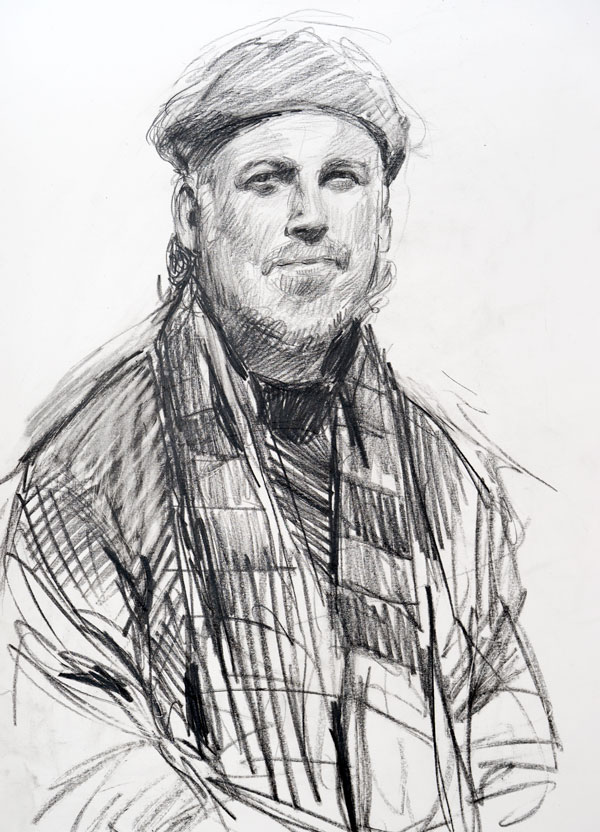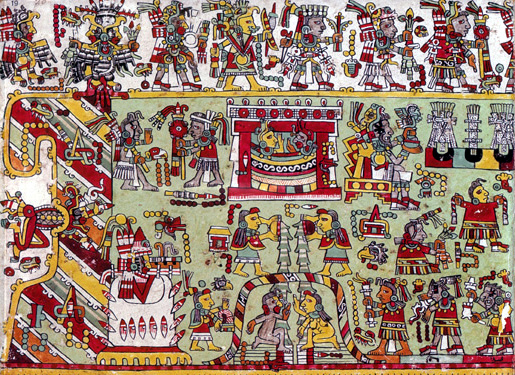|
Codex Colombino
The Codex Colombino is a part of a Mixtec codex held in the collection of the National Museum of Anthropology in Mexico City. It is the only Mesoamerican codex that remains in Mexican territory. It deals with the genealogy, marriages and bellicose conquests of the Mixtec lord Eight Deer Jaguar Claw ( fl. 11th century AD). The other half of the Colombino Codex is known as "Becker I", and was purchased by Phillip Becker, a German collector, from the Aja-Villagómez family in Acatlán de Osorio, Puebla. It is currently in Vienna. For that reason, the entire codex often goes by the name Codex Colombino-Becker. Several editions of both the ''Colombino'' and the ''Becker'' have been published. The most commonly used facsimile of the ''Colombino'' is accompanied by the commentary of Alfonso Caso (1966), and that of the ''Becker'' by the notes of Karl A. Nowotny (1961). For some of the history depicted in the ''Colombino-Becker'', there are cognate accounts in other Mixtec codices The M ... [...More Info...] [...Related Items...] OR: [Wikipedia] [Google] [Baidu] |
Mesoamerican Ballgame (Codex Colombino Folio 2)
The Mesoamerican ballgame ( nah, ōllamalīztli, , myn, pitz) was a sport with ritual associations played since at least 1650 BC by the pre-Columbian people of Ancient Mesoamerica. The sport had different versions in different places during the millennia, and a newer, more modern version of the game, ''ulama'', is still played by the indigenous populations in some places.Fox, John (2012)''The ball: discovering the object of the game"'' 1st ed., New York: Harper. . Cf. Chapter 4: "Sudden Death in the New World" about the Ulama game. The rules of the Mesoamerican ballgame are not known, but judging from its descendant, ulama, they were probably similar to racquetball, where the aim is to keep the ball in play. The stone ballcourt goals are a late addition to the game. In the most common theory of the game, the players struck the ball with their hips, although some versions allowed the use of forearms, rackets, bats, or handstones. The ball was made of solid rubber and weighe ... [...More Info...] [...Related Items...] OR: [Wikipedia] [Google] [Baidu] |
Acatlán De Osorio
Acatlán de Osorio is a city in the Mexican state of Puebla. The shortened name Acatlán, is commonly used to refer to the municipality of which it is the seat, and to the city itself. It is at an elevation of 1,213 m (3,981 ft). In the 2000 census the population of the city was 34,765. The name "Acatlán" comes from a combination of two Nahuatl words: ''acatl'', for "cane" or "reed", and ''tlan'', for "together" or "close". The name ''Osorio'' was in honor of Don Joaquín Osorio. The Mixtecs who ruled this area prior to the Spanish incursion called it Yucuyuxi. Acatlán was the capital of a state that was tributary to the Aztec Empire The Aztec Empire or the Triple Alliance ( nci, Ēxcān Tlahtōlōyān, Help:IPA/Nahuatl, �jéːʃkaːn̥ t͡ɬaʔtoːˈlóːjaːn̥ was an alliance of three Nahua peoples, Nahua altepetl, city-states: , , and . These three city-states ruled ....Peter Gerhard, ''A Guide to the Historical Geography of New Spain'' (Cambridge: Cambridge Un ... [...More Info...] [...Related Items...] OR: [Wikipedia] [Google] [Baidu] |
David Carrasco
Davíd Lee Carrasco is an American academic historian of religion, anthropologist, and Mesoamericanist scholar. As of 2001 he holds the inaugural appointment as Neil L. Rudenstine Professor of Latin America Studies at the Harvard Divinity School, in a joint appointment with the Faculty of Arts and Sciences' Department of Anthropology at Harvard University. Carrasco previously taught at the University of Colorado, Boulder and Princeton University and is known for his research and publications on Mesoamerican religion and history, his public speaking as well as wider contributions within Latin American studies and Latino/a studies. He has made statements about Latino contributions to US democracy in public dialogues with Cornel West, Toni Morrison, and Samuel P. Huntington. His work is known primarily for his writings on the ways human societies orient themselves with sacred places. Early life and education Carrasco descends from several generations of El Paso, Texas educators. ... [...More Info...] [...Related Items...] OR: [Wikipedia] [Google] [Baidu] |
Codex Zouche-Nuttall
The Codex Zouche-Nuttall or Codex Tonindeye is an accordion-folded pre-Columbian document of Mixtec pictography, now in the collections of the British Museum. It is one of about 16 manuscripts from Mexico that are entirely pre-Columbian in origin. The codex derives its name from Zelia Nuttall, who first published it in 1902, and Baroness Zouche, its donor. Description The Codex Zouche-Nuttall was probably made in the 14th century and is composed of 47 sections of animal skin with dimensions of 19 cm by 23.5 cm. The codex folds together like a screen and is vividly painted on both sides, and the condition of the document is by and large excellent. It is one of three codices that record the genealogies, alliances and conquests of several 11th and 12th century rulers of a small Mixtec city-state in highland Oaxaca, the Tilantongo kingdom, especially under the leadership of the warrior Lord Eight Deer Jaguar Claw (who died in the early twelfth century at the age of fifty-two ... [...More Info...] [...Related Items...] OR: [Wikipedia] [Google] [Baidu] |
Mixtec Codices
The Mixtec Group is the designation given by scholars to a number of mostly pre-Columbian documents from the Mixtec people of the state of Oaxaca in the southern part of the Republic of Mexico. They are distinguished by their principally historical and geographical content. Included in the Mixtec Group are: * The Codex Zouche-Nuttall. * The Codex Selden. * The Codex Colombino-Becker. * The Codex Waecker-Gotter. * The Codex Vindobonensis (or Vienna, as it is sometimes called). * The Codex Bodley. See also *Mixtec writing Mixtec writing originated as a logographic writing system during the Post-Classic period in Mesoamerican history. Records of genealogy, historic events, and myths are found in the pre-Columbian Mixtec codices. The arrival of Europeans in 1520 AD ... External links Mixtec Group codices [...More Info...] [...Related Items...] OR: [Wikipedia] [Google] [Baidu] |
Karl Anton Nowotny
Karl Anton Nowotny (June 21, 1904 in Hollabrunn – December 31, 1978 in Vienna) was an Austrian ethnographer, art historian and academic, specialising in the study of Mesoamerican cultures. He is most renowned for his analyses and reproductions of Mesoamerican codices, and his commentaries on their iconography and symbolisms. Nowotny was a pioneer and leading exponent of applying comparative ethnography to the study of pre-Columbian and conquest-era texts and codices. In this technique, the meaning and symbolism of the texts are analysed and compared with the cultural practices and beliefs of modern indigenous Mesoamerican peoples whose traditions have been maintained. Nowotny used comprehensive ethnographic studies—such as those conducted by Leonhard Schultze in the 1930s among the Nahuas of the central Mexican ''altiplano''—as a means of garnering further insight into the ancestral practices and beliefs underpinning the codices and related iconographies. Nowotny also con ... [...More Info...] [...Related Items...] OR: [Wikipedia] [Google] [Baidu] |
Alfonso Caso
Alfonso Caso y Andrade (February 1, 1896 in Mexico City – November 30, 1970 in Mexico City) was an archaeologist who made important contributions to pre-Columbian studies in his native Mexico. Caso believed that the systematic study of ancient Mexican civilizations was an important way to understand Mexican cultural roots. As a university student, he was part of a group of young intellectuals known as '' Los Siete Sabios de México'' ("The Seven Sages of Mexico") who founded Mexico City's "Society for Conferences and Concerts", which promoted cultural activity among the student population. One of the other Sages was Vicente Lombardo Toledano, who became Caso's brother-in-law after he married Lombardo's sister, writer María Lombardo: the couple had four children. After her death in 1966, he married her sister Aida. Caso completed a law degree in 1919 and immediately started teaching at the National Autonomous University of Mexico. The systematic legal training he received would ... [...More Info...] [...Related Items...] OR: [Wikipedia] [Google] [Baidu] |
Vienna
en, Viennese , iso_code = AT-9 , registration_plate = W , postal_code_type = Postal code , postal_code = , timezone = CET , utc_offset = +1 , timezone_DST = CEST , utc_offset_DST = +2 , blank_name = Vehicle registration , blank_info = W , blank1_name = GDP , blank1_info = € 96.5 billion (2020) , blank2_name = GDP per capita , blank2_info = € 50,400 (2020) , blank_name_sec1 = HDI (2019) , blank_info_sec1 = 0.947 · 1st of 9 , blank3_name = Seats in the Federal Council , blank3_info = , blank_name_sec2 = GeoTLD , blank_info_sec2 = .wien , website = , footnotes = , image_blank_emblem = Wien logo.svg , blank_emblem_size = Vienna ( ; german: Wien ; ba ... [...More Info...] [...Related Items...] OR: [Wikipedia] [Google] [Baidu] |
Puebla
Puebla ( en, colony, settlement), officially Free and Sovereign State of Puebla ( es, Estado Libre y Soberano de Puebla), is one of the 32 states which comprise the Federal Entities of Mexico. It is divided into 217 municipalities and its capital is the city of Puebla. It is located in East-Central Mexico. It is bordered by the states of Veracruz to the north and east, Hidalgo, México, Tlaxcala and Morelos to the west, and Guerrero and Oaxaca to the south. The origins of the state lie in the city of Puebla, which was founded by the Spanish in this valley in 1531 to secure the trade route between Mexico City and the port of Veracruz. By the end of the 18th century, the area had become a colonial province with its own governor, which would become the State of Puebla, after the Mexican War of Independence in the early 19th century. Since that time the area, especially around the capital city, has continued to grow economically, mostly through industry, despite being the scene o ... [...More Info...] [...Related Items...] OR: [Wikipedia] [Google] [Baidu] |
Mixtec Codex
The Mixtec Group is the designation given by scholars to a number of mostly pre-Columbian documents from the Mixtec people of the state of Oaxaca in the southern part of the Republic of Mexico. They are distinguished by their principally historical and geographical content. Included in the Mixtec Group are: * The Codex Zouche-Nuttall. * The Codex Selden. * The Codex Colombino-Becker. * The Codex Waecker-Gotter. * The Codex Vindobonensis (or Vienna, as it is sometimes called). * The Codex Bodley. See also *Mixtec writing Mixtec writing originated as a logographic writing system during the Post-Classic period in Mesoamerican history. Records of genealogy, historic events, and myths are found in the pre-Columbian Mixtec codices. The arrival of Europeans in 1520 AD ... External links Mixtec Group codices [...More Info...] [...Related Items...] OR: [Wikipedia] [Google] [Baidu] |
Floruit
''Floruit'' (; abbreviated fl. or occasionally flor.; from Latin for "they flourished") denotes a date or period during which a person was known to have been alive or active. In English, the unabbreviated word may also be used as a noun indicating the time when someone flourished. Etymology and use la, flōruit is the third-person singular perfect active indicative of the Latin verb ', ' "to bloom, flower, or flourish", from the noun ', ', "flower". Broadly, the term is employed in reference to the peak of activity for a person or movement. More specifically, it often is used in genealogy and historical writing when a person's birth or death dates are unknown, but some other evidence exists that indicates when they were alive. For example, if there are wills attested by John Jones in 1204, and 1229, and a record of his marriage in 1197, a record concerning him might be written as "John Jones (fl. 1197–1229)". The term is often used in art history when dating the career ... [...More Info...] [...Related Items...] OR: [Wikipedia] [Google] [Baidu] |
.png)

